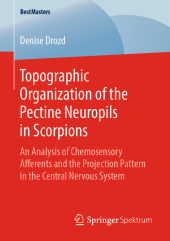 Neuerscheinungen 2019Stand: 2020-02-01 |
Schnellsuche
ISBN/Stichwort/Autor
|
Herderstraße 10
10625 Berlin
Tel.: 030 315 714 16
Fax 030 315 714 14
info@buchspektrum.de |

Denise Drozd
Topographic Organization of the Pectine Neuropils in Scorpions
An Analysis of Chemosensory Afferents and the Projection Pattern in the Central Nervous System
1st ed. 2019. 2019. xi, 47 S. 1 SW-Abb. 210 mm
Verlag/Jahr: SPRINGER, BERLIN; SPRINGER FACHMEDIEN WIESBADEN 2019
ISBN: 3-658-25154-9 (3658251549)
Neue ISBN: 978-3-658-25154-3 (9783658251543)
Preis und Lieferzeit: Bitte klicken
Chelicerates do not possess dedicated antennae like the Mandibulata but have evolved their second sets of appendages into the eponymous chelicerae. In scorpions, pectines are specialized comb-like structures, located on the ninth body segment, used for examining the substrate for chemo- and mechanosensory signals. The comb teeth, or pegs, are truncated beveled structures facing the substrate for probing, and are studded with numerous sensory receptors. Afferents from the pectines project into a distinct neuropil of the central nervous system, located behind the fourth walking leg neuropils. Denise Drozd analyzes afferents of single pegs in Mesobuthus eupeus by backfilling, combined with immunohistological labeling of neuropil regions. Her results suggest a topographic representation of the chemosensory fibers within the pectine neuropil instead of the typical chemotopic representation.
The Nervous System of Scorpions.- Structural Analysis of the Posterior Pectine Neuropil.- Projection Areas of Chemosensory Afferents.
Denise Drozd is a PhD candidate of Prof. Dr. Harald Wolf at the Institute of Neurobiology at Ulm University, Germany.


